Snapshot
Market dynamics have changed quite considerably since mid-March after the regional bank failures in the US, which were quickly followed by turmoil at Credit Suisse leading to the bank’s forced marriage with UBS. The government response was swift and significant, and while central banks have attempted to message a somewhat normal return to its tighter policy agenda, markets simply are not buying it.
It is usually not wise to “fight the Fed” but it might just be a reasonable wager as the economy begins to feel the effects of an extensive tightening cycle to date (and now tighter bank credit), while the notion of continued rate hikes and staying “higher for longer” inflicting the very pain that is distressing banks does seem to be a stretch.
Bonds and gold have continued the rally, while equity classes have quickly shifted course, shedding banks and value assets exposed to the real economy, favouring instead long duration quality assets like large-cap tech and utilities. The benefit for multi-asset portfolios is that equity-bond correlations have shifted once again to be negative where duration can again protect equity downside, and gold is a new safe asset on the back of a weaker dollar and elevated risk of policy mistake.
It is still difficult to know the contours and extent of the slowdown ahead, but in our view, there is now proper risk balance between equities, bonds, cash and gold, and this helps to deliver better risk-adjusted returns under a variety of scenarios.
Cross-asset 1
We decreased the growth score and marginally lifted the defensive score, both a reflection of increasing growth headwinds where banking stress in the US and EU will pile onto challenges in the form of tighter credit conditions ahead, which adds to headwinds of already high rates. Our reduced growth score reflects change to our three to six month view, but in late March we did take a brighter view towards equities on the premise that markets were simply too bearish on the bank situation. The regional bank failures in the US and the forced marriage between UBS and ailing Credit Suisse in the EU may conjure parallels with the Great Financial Crisis. However, we believe that the situation is quite different with stress driven by higher rates marking lower book values in bank bond portfolios (a liquidity problem) versus 2008 when banks were ladened with dubious assets exacerbated by extreme leverage.
The silver lining is that central banks are nearing the end of their tightening cycles, if not already there; growth concerns are dominating inflation, allowing bond-equity correlations to shift towards negative which we think is sustainable. Within growth, we decreased emerging market (EM) and commodity-linked equities given the headwinds to near-term growth versus China’s recovery. Within defensives, we reduced credit to larger underweights and neutralised EM local currency bonds to fund additions to developed market (DM) sovereigns and gold, which are attractive defensive assets to slowing growth and an eventual central bank pivot.
1The Multi Asset team’s cross-asset views are expressed at three different levels: (1) growth versus defensive, (2) cross asset within growth and defensive assets, and (3) relative asset views within each asset class. These levels describe our research and intuition that asset classes behave similarly or disparately in predictable ways, such that cross-asset scoring makes sense and ultimately leads to more deliberate and robust portfolio construction.
Asset Class Hierarchy (Team View2)
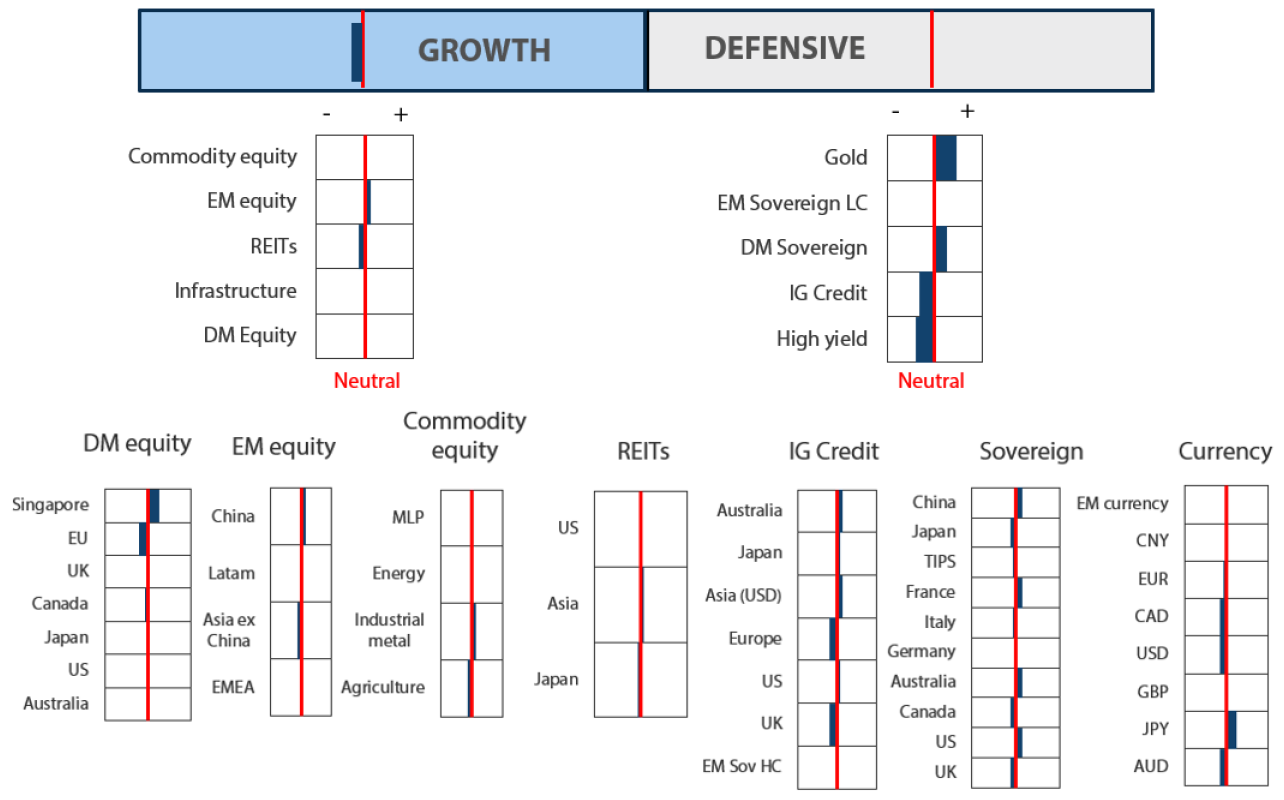
2The asset classes or sectors mentioned herein are a reflection of the portfolio manager’s current view of the investment strategies taken on behalf of the portfolio managed. The research framework is divided into 3 levels of analysis. The scores presented reflect the team’s view of each asset relative to others in its asset class. Scores within each asset class will average to neutral, with the exception of Commodity. These comments should not be constituted as an investment research or recommendation advice. Any prediction, projection or forecast on sectors, the economy and/or the market trends is not necessarily indicative of their future state or likely performances.
Research views
Growth assets
Equities were throttled into the banking crisis mid-March, as one would expect, and while bank stocks remain under pressure, other pockets of the market such as the “mega-cap tech” (MAGMAN: Microsoft, Apple, Google, Meta, Amazon and Nvidia) were quick to grind higher to levels not seen in over a year. What is going on here? These strong companies are logically deemed a safer asset than smaller-cap peers that are more reliant on credit—which is getting tighter—and cyclical demand, and these companies are long duration assets that benefit from compressing yields. We have maintained a subdued view towards growth stocks since early 2022 as a function of expensive valuations and likely earnings mean-reversion to the downside, but we have reconsidered this proposition—particularly in view of some of the fast growth developments connected with artificial intelligence (AI).
Prior cycles can be useful analogues to understand what might be coming next, and the tech boom of this cycle is similar to the “dot-com” boom of the late 1990s/early 2000s. However, there are important differences including valuations and the relative vulnerability of earnings. In the late 1990s, much of the tech sector was simply not profitable and those that were depended on demand from the Internet ecosystem that was deeply damaged. Today, valuations are still high but not nearly at dot-com levels and profits are more diversified across the broad economy. Of course, sources of revenue are at risk should the US hit a deep recession, but a shallower recession could have less of an impact on demand for continued investment.
From a broader portfolio perspective, today there are arguably fewer safe assets than in 2000, and it is possible that companies with strong balance sheets and cash flow have safety attributes attracting capital for lack of better options elsewhere. Back in 2000, inflation peaked at 3.7% when the 10-year US Treasury (UST) yielded 6.5%, offering a +2.8% real yield which increased to +4% as inflation receded. USTs were indeed a safe asset, and investors duly flocked to them. Today, inflation has declined from a 9% peak to just under 5%, while USTs yield less than 3.5% for a -1.5% real yield. This is certainly less attractive, particularly when also considering US debt-to-GDP has more than doubled from 55% in 2000 to 130% today while inflation uncertainty remains. This is unconventional thinking but perhaps important to bear in mind as one considers the optimal portfolio to weather the storms that may lie ahead.
Reassessing growth risks
The secular growth theme in tech began in earnest around 2015 on the back of disruptive technologies that began to have a significant impact on the real world—from electric vehicles, alternative energies, machine learning to connected devices along with faster and more powerful processors allowing innovations to leap forward. The combination of outsized stimulus following COVID in 2020 and changed work and leisure habits created outsized opportunities for tech, driving earnings and valuations sky high. Something had to give, and it did in 2022 as earnings gave back and companies derated on the back of higher rates. Is the shakeout over?
Chart 1: NASDAQ price versus Bloomberg Estimates (BEst) earnings per share (EPS)
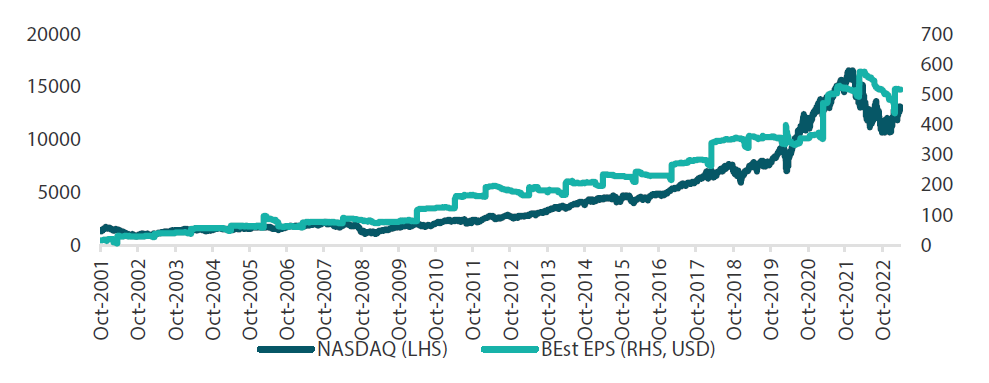
Source: Bloomberg, April 2023
Certainly, bubbles burst but there has yet to be a complete washout as some expected, though it looked close from a price perspective late in 2022 as NASDAQ fell 35% from the prior high. In 2023, NASDAQ is up about 21% as of this writing, which is an extraordinary rebound and maybe too fast. Viewing NASDAQ price and EPS together in Chart 1 above, shows that they are back down to levels consistent with the trend prior to COVID, but is the correction over? Microsoft is an interesting case study given its participation in both bubbles. Chart 2 compares the stock’s price-to-earnings (PE) ratios over the last four years to the comparable boom-and-bust period back during the dot-com bubble. Clearly, valuations in the 2000s were in a different league.
Chart 2: Comparison of Microsoft’s PE from the dot-com bubble period versus today
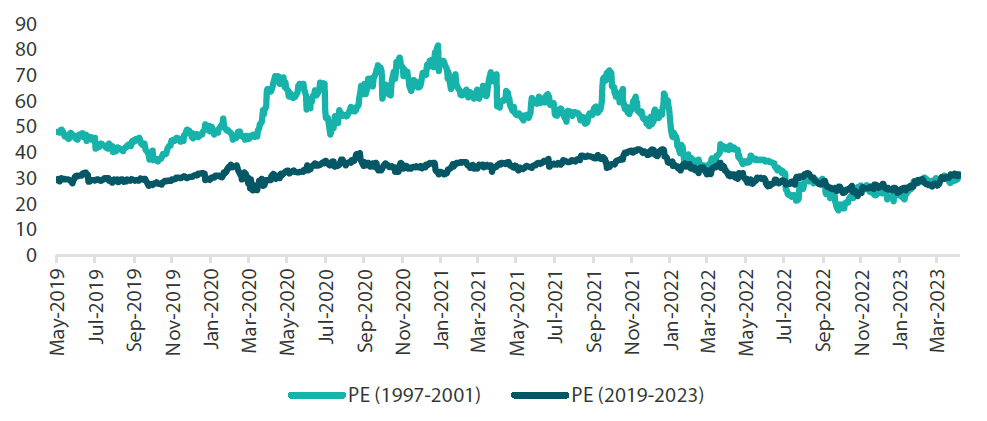
Source: Bloomberg, April 2023
Back in the early 2000s, stocks did not bottom until 2002, and Microsoft’s PE bottomed at just under 17 in 2004 as earnings began to recover while the market was still hesitant to buy tech. Of course, PEs could continue to compress and earnings could continue to deteriorate taking the price down further—particularly if there is a deeper recession —but the earnings outlook today is considerably more supportive than the early 2000s with new innovations including AI that have been taking the world by storm since late 2022.
We also take into account that safe assets are in limited supply, so it may be that strong companies are ultimately deemed a better store of value than the negative real yield in bonds, particularly if there is discernible top-line growth that can help to hedge to higher inflation. We are far from bullish given our negative view on the growth outlook overall, but these are worth considerations as secular growth may play a sensible role in a broader portfolio strategy for income and growth.
Conviction views on growth assets
- Balanced risk and durable growth: We believe the negative correlation between bonds and equities is likely to be sustainable as growth fears overcome inflation fears. In this context, we like combining duration assets (and gold) with equities that offer durable earnings including pockets of secular growth and also defensive sectors including healthcare, consumer staples and utilities to weather the coming slowdown.
- Cautious banks: While banking issues seem isolated to regionals in the US and some banks in Europe, the interconnectedness of the sector could continue to weigh on banks around the world. To that end, we have been taking a more cautious view of the banking sector in favour of other more promising sectors within different geographies—such as consumer staples, healthcare, utilities and raw materials.
- Waiting on China: We still like the beneficiaries of China’s re-opening, from Asia to Europe and beyond, but the theme has been a bit of a disappointment to date as improved activity has yet to translate into meaningful new demand. China and other markets are still cheap and growth prospects are improving, but it may take time to come to fruition, which is why we seek better diversification such as through the themes described above.
Defensive assets
We increased our overweight view on sovereign bonds this month. At the beginning of March, investors were anticipating a new round of economic data and a full slate of central bank meetings. Most of these meetings delivered further rate hikes as markets expected. But along the way, two US banks failed and a large Swiss bank was rescued, raising concerns about the soundness of the global banking system and triggering a flight to safety bid in global sovereign bonds. In the aftermath of this banking scare, the end of central bank tightening is likely to now happen sooner than we expected.
Higher rates were already a growing headwind for credit but we believe that the recent turmoil in the banking system is only going to add to this tightening of liquidity and credit conditions. On the positive side, credit quality was robust at the start of 2023 so corporates are expected to have some ability to weather this storm. But eventually, we expect the pressures to only increase and keep risk appetite subdued. Across the credit spectrum, the high yield sector carries more leverage than high grade and could be even more susceptible to funding difficulties in the current environment. Traditional lags in monetary policy mean the global economy has yet to feel the full impact of tighter policy so we remain negative on corporate bonds.
Gold has continued to perform well as banking concerns linger, and as central banks look to further diversify their reserves. We expect the precious metal to retain its appeal given rising recession risks and a potentially weaker dollar—both factors providing strong tailwinds.
US recession probabilities
As some of the major central banks have paused their tightening cycles, and others are close to following suit, markets are keenly attuned to the impact of this course of rate hikes on the global economy. For the US, economic growth has so far been resistant to the Fed’s aggressive rate hiking campaign over the last year. However, this is essentially a backward-looking assessment and so the important question becomes, will the US economy continue to hold out against the Fed’s efforts to slow it down?
On this question, we are mostly in line with the market consensus view that the answer is no, and that the US economy will start to show signs of a significant slowing in coming months. Another way to consider this question is to frame the answer in terms of the probability the US will be in a recession over the next 12 months. The latest Bloomberg survey of market economists reveals that the median forecasted probability of recession is 65% (based on 55 contributors). While this forecast undoubtedly includes a healthy dose of subjective analyses from respondents, market analysts have also developed several more objective indicators to forecast recession probabilities.
Chart 3 shows three common indicators that utilise the shape of the USTs yield curve. Two of these measures—the spread between the 3-month rate and the 18-month forward 3-month rate, and the spread between 3-month rates and 10-year bonds yields—are often cited by the Fed. The third measure is a favourite of markets and is the spread between 2-year and 10-year bond yields. As we can see, all these yield curve-based indicators show a probability of recession of greater than 60%, with the highest being 86%. And looking back to the turn of the new century, these indicators all have a strong track record of signalling impending US recessions.
Chart 3: US recession probabilities based on yield curve (YC) spreads
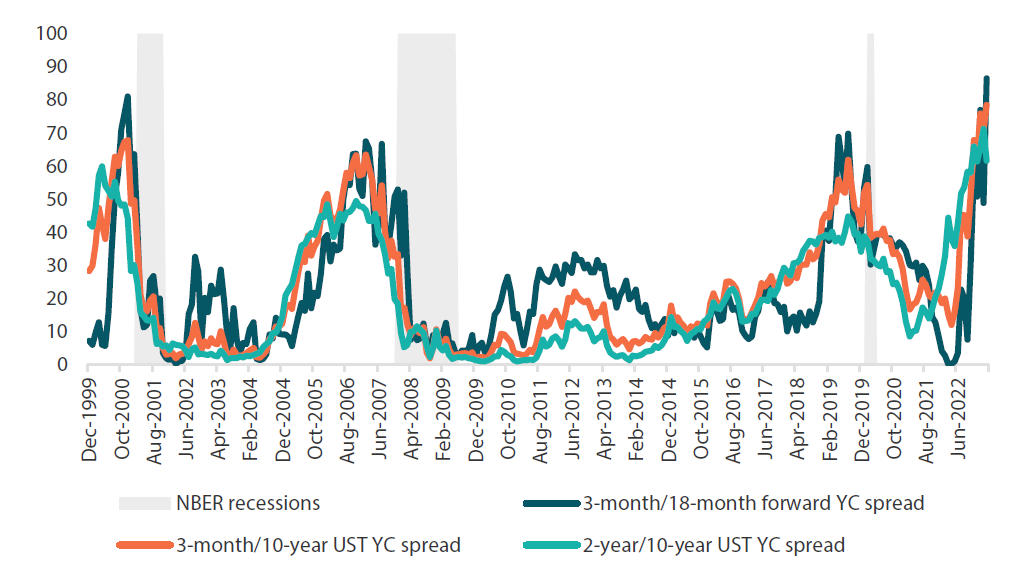
Source: Bloomberg, April 2023
Other recession indicators seek to include a broader set of variables than just the shape of the yield curve and we show two such recession probability indicators from Bloomberg Economics (BE) and Morgan Stanley (MS) in Chart 4. Both utilise macro-economic variables as well as financial variables to forecast the likelihood of a US recession within 12 months. The BE measure has been warning of an impending recession since last August and the MS measure has risen but is still short of forecasting a recession.
Chart 4: US recession probabilities based on broad indicators
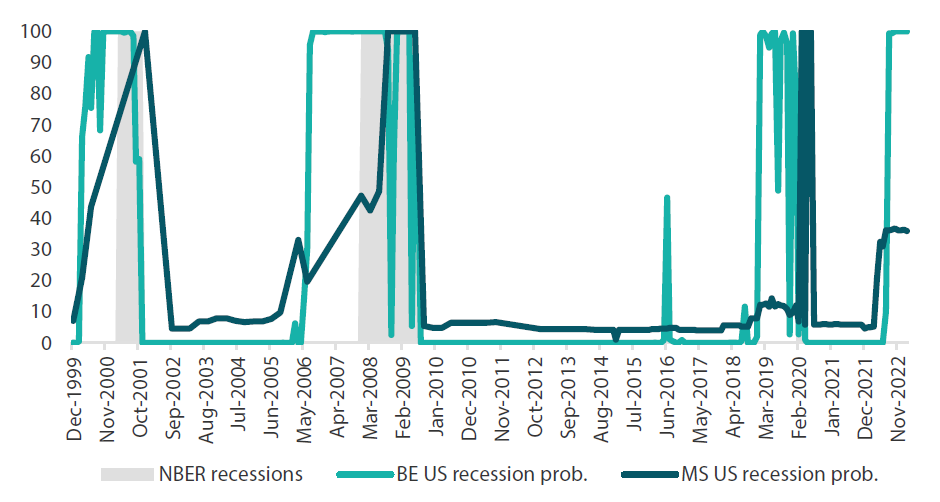
Source: Bloomberg, March 2023
Whichever recession probability forecast we choose, they indicate that recession warnings have been rising over the last six months. The Fed has so far kept an almost singular focus on promoting tighter monetary policy in its fight to reduce inflation and downplayed indications of slowing demand. But as the Fed approaches its own expectations for the peak Fed funds rate, we expect it to become more sensitive to these signs of slower growth.
Conviction views on defensive assets
- Prefer sovereigns over credit: The late stages of central bank tightening cycles are generally not kind to credit spreads and credit quality. Therefore, we prefer sovereign bond exposures.
- Gold can continue to perform: The twin headwinds of rising real yields and a stronger dollar are fast receding, and safe-haven interest is rising, fuelling support for gold prices.
Process
In-house research to understand the key drivers of return:
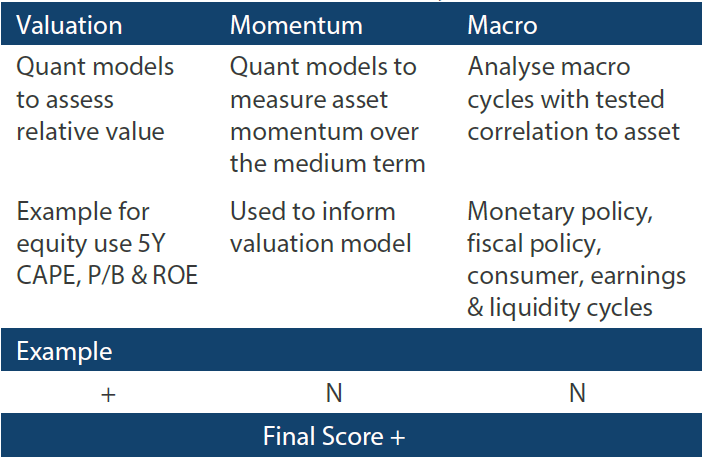
Any reference to a particular security is purely for illustrative purpose only and does not constitute a recommendation to buy, sell or hold any security. Nor should it be relied upon as financial advice in any way.



